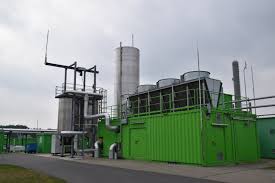- What is BioGas ?
Biogas is a type of gas produced through the decomposition of organic matter, such as animal dung, agricultural waste, and other organic residues. This gas is primarily composed of methane and carbon dioxide.
Some key uses of biogas include:
1. Fuel: Biogas can be used for cooking, electricity generation, and as a fuel for vehicles.
2. Energy source: Biogas is a renewable energy source, more environmentally friendly compared to fossil fuels.
3. Fertilizer: The residue left after biogas production can be used as fertilizer, improving soil fertility.

Various organic materials can be used for biogas production, including:
1. Animal dung: Biogas can be produced from animal waste.
2. Agricultural waste: Biogas can be produced from crop residues and other organic waste.
3. Sewage: Biogas can also be produced in sewage treatment plants.
Biogas is a clean and renewable energy source that plays a significant role in environmental protection and energy security.
- Here’s the full process of how biogas is produced?
Biogas Production Process
1. Organic Material Collection: Organic materials such as animal dung, agricultural waste, and other organic residues are collected.
2. Slurry Preparation: The organic materials are mixed with water to create a slurry.
3. Digester Filling: The slurry is fed into a specially designed tank called a digester.
4. Anaerobic Digestion: Microorganisms in the digester break down the organic matter in anaerobic conditions, producing methane and carbon dioxide gases.
5. Gas Collection: The produced gas is collected in a separate tank.
6. Gas Purification: If necessary, the gas is purified to remove impurities.
7. Usage: The purified gas can be used for cooking, electricity generation, or as a fuel for vehicles.
Benefits of Biogas Production
– Renewable Energy Source: Biogas is a renewable energy source that is more environmentally friendly compared to fossil fuels.
– Organic Waste Management: Biogas production helps in managing organic waste.
– Economic Benefits: Biogas production can also provide economic benefits, especially in rural areas.
Biogas production is a clean and renewable energy source that plays a significant role in environmental protection and energy security.
- Where is BioGas used?
Biogas can be used in various sectors, some of the main uses include:
1. Cooking: Biogas can be used for cooking, providing a clean and safe fuel.
2. Electricity Generation: Biogas can be used to generate electricity, helping to meet power needs in rural areas.
3. Vehicle Fuel: Biogas can be used as a fuel for vehicles, offering a more environmentally friendly alternative to petrol and diesel.
4. Industrial Applications: Biogas can be used as an energy source in industries such as food processing and textile manufacturing.
5. Greenhouse Gas Reduction: Biogas production and use can help reduce greenhouse gas emissions, contributing to climate change mitigation. Benefits of Biogas
Benefits of Biogas
– Renewable Energy Source: Biogas is a renewable energy source that is more environmentally friendly compared to fossil fuels.
– Organic Waste Management: Biogas production helps manage organic waste.
– Economic Benefits: Biogas production can provide economic benefits, especially in rural areas.
- What are the main components of BioGas ?
The main components of biogas are:
| 1. Methane (CH4): | Methane is the primary component of biogas, making up approximately 50-70%. It is a flammable gas that can be used as an energy source. |
| 2. Carbon Dioxide (CO2) | Carbon dioxide is the second major component of biogas, making up around 30-50%. It is a greenhouse gas that contributes to climate change. |
| 3. Hydrogen Sulfide (H2S) | Hydrogen sulfide is an impurity that can be present in biogas. It is a toxic gas that can be harmful to health. |
| 4. Nitrogen (N2) and Oxygen (O2): | Nitrogen and oxygen can also be present in biogas, but in much smaller quantities. |
The composition of biogas can vary dependingon factors such as the type of organic matter, temperature, and digestion process duration.
- What are the advantages and disadvantages of BioGas ?
Biogas can have both benefits and drawbacks. Here are some key advantages and disadvantages:
Benefits of Biogas
1. Renewable Energy Source: Biogas is a renewable energy source that is more environmentally friendly compared to fossil fuels.
2. Organic Waste Management: Biogas production helps manage organic waste.
3. Economic Benefits: Biogas production can provide economic benefits, especially in rural areas.
4. Greenhouse Gas Reduction: Biogas production and use can help reduce greenhouse gas emissions.
Drawbacks of Biogas
1. Toxic Gases: Biogas can contain toxic gases like hydrogen sulfide, which can be harmful to health.
2. Explosive: Biogas can be explosive due to its high methane content, posing a safety risk.
3. High Costs: Setting up and maintaining biogas production plants can be expensive.
4. Availability of Organic Waste: Biogas production requires a steady supply of organic waste, which may be limited in some areas.
- What is the formula of BioGas?
Biogas does not have a fixed chemical formula, as it is a mixture of various gases. The main components of biogas are:
- Methane (CH4)
- Carbon dioxide (CO2)
The composition of biogas can vary in terms of methane and carbon dioxide content, depending on factors such as the nature of the organic matter, temperature, and digestion process duration.
Typically, biogas composition can be:
- Methane (CH4): 50-70%
- Carbon dioxide (CO2): 30-50%
Therefore, there is no single chemical formula for biogas, but the chemical formulas for its main components are:
- Methane: CH4
- Carbon dioxide: CO2
Read More,
- fukra Insaan kon hai ?
- Mery kom kyu famous hai ?
- What is Blinkit App?
- What is Direct Selling Business?
- Agriculture Kya hai ?